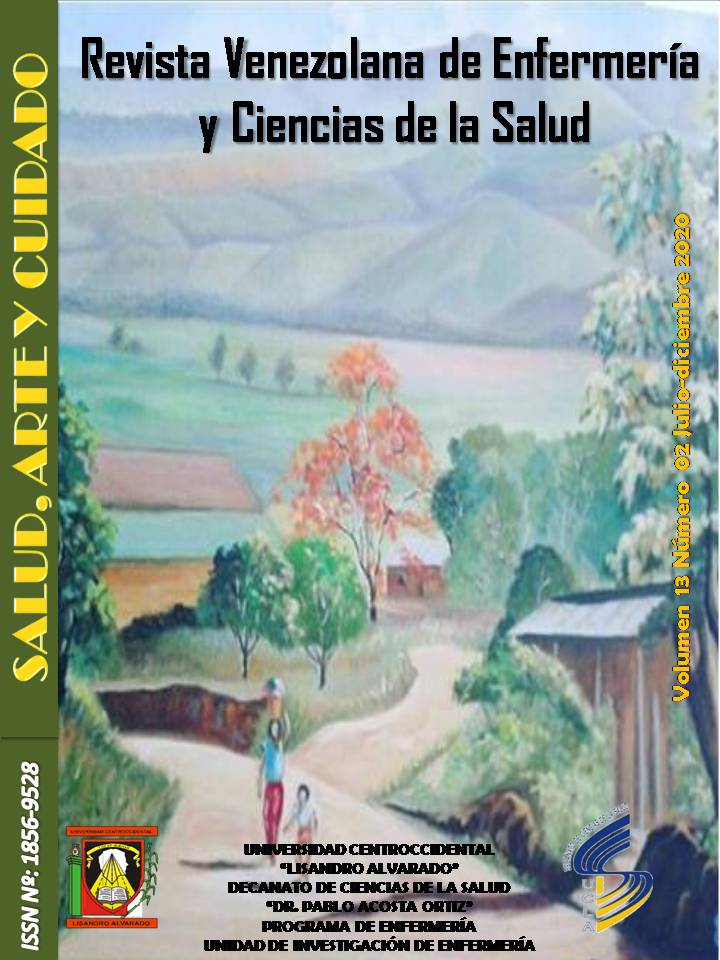Clinical and epidemiological characterization of patients with diagnosis of scabiosis in the sanitary dermatology consultation
DOI:
https://doi.org/10.5281/zenodo.6828912Keywords:
ectoparasitosis, sarcoptes scabiei, scabiesAbstract
The objective of this research was to analyze the clinical and epidemiological characterizations in patients with a diagnosis of scabies in the Sanitary Dermatology consultation of the Adarigua Outpatient Clinic. Retrospective, non-experimental descriptive research, the medical records of 126 patients consulted in 2018 was reviewed, in a form type data collection sheet, applied with prior authorization by the director of the Adarigua outpatient clinic. The data collected were processed and the measures of relative frequency (percentage). The results regarding the sociodemographic characteristics reported in the records of adult patients predominate 65% female, while pediatric patients predominate 52% male, the consultation months with the highest number of adult patients were January, February, followed by June, October, May and November respectively, while pediatric patients were January and October. On the other hand, the findings of the clinical characterization report the histories of adult patients that 94% present intense itching, 91% eruptions with bumps and 91% do not present hyperkeratotic in the hands and feet; 97% do not present adenopathy and pediatric patients 57% present intense itching, 75% eruptions with bumps and 52% present hyperkeratotic in the hands and feet and 95% do not present adenopathy, on the other hand the type of lesions of adult patients are characterized by To be 85% extensive and 15% are localized and pediatric patients 29% extensive and 71%, the prescribed treatment of adult patients was 100% Ivermectina tablets, topical Permethrin, Dexpanthenol Cream, Antihistamine and recommendations for Hygiene Measures, while that prescribed in pediatric patients Permethrin 99%, Dexpanthenol cream 100%, Antihistamines 76% drops, 16% suspension and 11% tablets recommendations for hygienic measures in 100% of cases.
Downloads
References
Dionisio de Cabalier, María Elisa y Chalub, Delia María. El Aprendizaje Significativo de las Ciencias Morfológicas en Medicina: Experiencia y Aportes para su Enseñanza en Clínica Dermatológica. Int. J. Morphol. [online]. 2009, vol.27, n.2, pp.565-569. ISSN 0717-9502. http://dx.doi.org/10.4067/S0717-95022009000200041.
Fundación Jacinto Convit (2018) Jacintoconvit.org.ve/es/antecedentes/red-dermatológica. Consultada 22 SEP 2021
Rodríguez-Zúñiga, Milton José Max, Torres-Panduro, Natalie, Escabiosis en Lima y Callao, 2016. Acta Médica Peruana 2017, 34 (Octubre-Diciembre)
Santamaría D (2017) Caracterización clínica y epidemiológica de pacientes con diagnóstico de escabiosis en el Centro de salud de Quisapincha Facultad de Ciencias Médicas Carrera de Medicina Universidad Regional Autónoma de los Andes “Uniandes” Ambato – Ecuador
Organización Mundial de la Salud y Organización Panamericana de la salud (OMS/OPS) (2009).Disponible en https://www.paho.org/es/temas/ectoparasitosis
González A, Rossito A, González S. Escabiosis: una enfermedad reemergente. EntomolVect 2003; 10: 621-33.
Galván Pérez JI. “Historia de la sarna”. Piel 2004; 19: 533-537
Plasencia Gómez A, Proy Trujillo H, Eljure López N, Atoche Diéguez C, Calderón Rocher C. Escabiosis: una revisión. Dermatología CMQ. 2013; 11(3):217-223.
Tincopa Wong Oscar W. Scabiosis (sarna): Revisión epidemiológica, clínica, patogénica y terapéutica. Dermatol Perú 2017; VOL 27 (2)
Costa M; Rodríguez O; García A; Rodríguez N Escobar 2018 Aspectos epidemiológicos de la escabiosis infantil en el Municipio Cabimas, Estado Zulia, Venezuela.
Menghi, Claudia I., Arias, Liliana E., Gatta, Claudia L., Diagnóstico de un caso de escabiosis en la ciudad de Buenos Aires. Revista Argentina de Microbiología [en línea] 2016, 48 [Fecha de consulta: 11 de enero de 2021] Disponible en:<http://www.redalyc.org/articulo.oa?id=213045299016> ISSN 0325-7541
Costa García; María Leticia Rodríguez Heredia; Odalys. García Perera; Alis. Rodríguez Escobar Norma 2018 Aspectos epidemiológicos de la escabiosis infantil en el municipio Cabimas, estado Zulia, Venezuela. REDALYC
Max Rodríguez Milton José y Torres-Panduro Zúñiga Natalie Escabiosis en Lima y Callao Acta Med Perú. 2016; 34(4):335-6 3 REDALYC
Caumes, E., Ndaw, C., Ndiaye, B., & Mahe, A. (2009). Ivermectina versus benzyl benzoate applied once or twice to treat human scabies in Dakar, Senegal: a randomized controlled trial. Bull WHO, 87, 424-430.
Chaiya, S., Patel, V., Dave, J., Mehta, D., & Shah, H. (2012). Comparative efficacy and safety of topical Permethrin, topical ivermectina, and oral ivermectina in patients of uncomplicaded scabies. Indian J Dermatol Venereol Leprol, 78, 605-610.
Casals M. (2021). Sarna: una epidemia dentro de una pandemia [Scabies: An epidemic within a pandemic]. Piel, 36(5), 281–283. https://doi.org/10.1016/j.piel.2021.02.006
Published
How to Cite
Issue
Section

This work is licensed under a Creative Commons Attribution-NonCommercial-ShareAlike 4.0 International License.
Derechos del/de autor/es a partir del año de publicación
Esta obra está bajo la licencia:
Creative Commons Reconocimiento-NoComercial-CompartirIgual 4.0 Internacional (CC BY-NC-SA 4.0)
Las opiniones expresadas por los autores no necesariamente reflejan la postura del editor de la publicación ni de la UCLA. Se autoriza la reproducción total o parcial de los textos aquí publicados, siempre y cuando se cite la fuente completa y la dirección electrónica de esta revista. Los autores(as) tienen el derecho de utilizar sus artículos para cualquier propósito siempre y cuando se realice sin fines de lucro. Los autores(as) pueden publicar en internet o cualquier otro medio la versión final aprobada de su trabajo, luego que esta ha sido publicada en esta revista.






